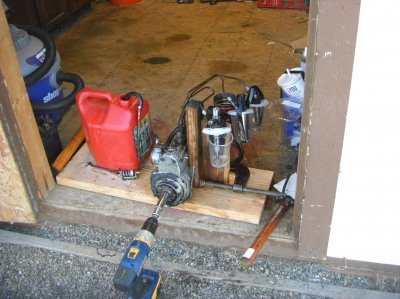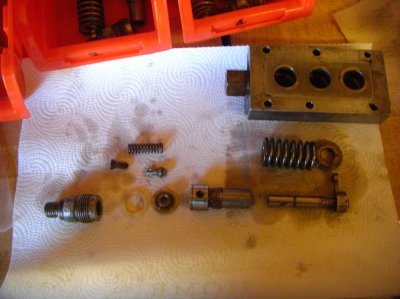jaluhn83
Full Access Member
Got an issue with a Ford 3500 tractor I'm rebuilding and wanted to get some thoughts. I know this is off topic but this seems the best place to get info. Mods, I'll delete this in a few days or move it.
The tractor is a 3 cylinder IDI ford motor, 172 CI with a inline injection pump (Simms Minimec) I bought it as a basket case with the head off and significant rust in the bores. Seems the head was pulled about 10 years ago and then owner deployed and while he was gone the cover blew off and it got rained on. Wound up needing sleeves in all 3 cylinders. The injection pump also looked like it was exposed to water. Injectors had some rust but mostly surface. I've got the engine back together and in the tractor now but I cannot get it run - as far as I can tell it's not actually injecting fuel.
I've got clean fuel to the pump, good life pump pressure and the low pressure side has been bled multiple times. I'm getting fuel delivery and I've bled the injector lines several times and cranked it a ton, even to the point of having it running on starting fluid for a bit. Still no sign of any fuel actually getting injected. With the lines loosened I get a good squirt of fuel from each line.
The injection pump did have rust problems in the delivery valves and I wound up having to disassemble the hydraulic head, clean the delivery valves and seats and lap to the valves. The actual plungers and bores were clean with no signs of rust or damage. They felt tight in the bores and all of the fuel flow ports were open and clean. All of the parts were put back in their proper locations and the plungers are engaging the rack properly. The rack moves freely and the governor seems to be working properly. After fixing the delivery valves I get a nice clean squirt of fuel from each port and the shutoff lever does stop fuel flow. The quantity of fuel *seems* about right though it's hard to say for sure. Should be enough to at least make some smoke anyway. The cams did have some rust on them when I checked but I can't tell if it's new or not and there doesn't seem to be enough damage to cause problems.
I also removed the nozzle holders on all 3 injectors and cleaned and inspected the nozzles and plungers. All were clean, seemed to fit well and were free. I don't have a pop tester yet so I can't fully verify proper function, but I didn't see anything that looked horribly wrong.
When cranking I get no smoke or evidence of any fuel injection. I even tried connecting on of the injectors sideways so I could see the tip and I saw no evidence of fuel.
So, any thoughts? Everything I've looked at has seemed ok. It would not surprised me if it was a bit off somehow, either from damage or from me messing up putting something back together, but I can't think of anything that would fit the symptoms. I'm definitely getting flow to the injectors, and it's making enough pressure to lift the delivery valve (1-200 psi???) and delivery a healthy slug of fuel, but yet apparently not enough to lift the injector. About the only thing I can think is I still have air in the system somewhere. However, with a much as I've played with it (probably close to 30 minutes total cranking time) I find it hard to believe there's not something else going on. On the 6.9 with a new pump, blown out lines and new injectors I don't recall it taking more than 1-2 minutes.
This things seriously starting to make me pull my hair out... and I don't have enough left to do much of that!
Thanks,
~John
The tractor is a 3 cylinder IDI ford motor, 172 CI with a inline injection pump (Simms Minimec) I bought it as a basket case with the head off and significant rust in the bores. Seems the head was pulled about 10 years ago and then owner deployed and while he was gone the cover blew off and it got rained on. Wound up needing sleeves in all 3 cylinders. The injection pump also looked like it was exposed to water. Injectors had some rust but mostly surface. I've got the engine back together and in the tractor now but I cannot get it run - as far as I can tell it's not actually injecting fuel.
I've got clean fuel to the pump, good life pump pressure and the low pressure side has been bled multiple times. I'm getting fuel delivery and I've bled the injector lines several times and cranked it a ton, even to the point of having it running on starting fluid for a bit. Still no sign of any fuel actually getting injected. With the lines loosened I get a good squirt of fuel from each line.
The injection pump did have rust problems in the delivery valves and I wound up having to disassemble the hydraulic head, clean the delivery valves and seats and lap to the valves. The actual plungers and bores were clean with no signs of rust or damage. They felt tight in the bores and all of the fuel flow ports were open and clean. All of the parts were put back in their proper locations and the plungers are engaging the rack properly. The rack moves freely and the governor seems to be working properly. After fixing the delivery valves I get a nice clean squirt of fuel from each port and the shutoff lever does stop fuel flow. The quantity of fuel *seems* about right though it's hard to say for sure. Should be enough to at least make some smoke anyway. The cams did have some rust on them when I checked but I can't tell if it's new or not and there doesn't seem to be enough damage to cause problems.
I also removed the nozzle holders on all 3 injectors and cleaned and inspected the nozzles and plungers. All were clean, seemed to fit well and were free. I don't have a pop tester yet so I can't fully verify proper function, but I didn't see anything that looked horribly wrong.
When cranking I get no smoke or evidence of any fuel injection. I even tried connecting on of the injectors sideways so I could see the tip and I saw no evidence of fuel.
So, any thoughts? Everything I've looked at has seemed ok. It would not surprised me if it was a bit off somehow, either from damage or from me messing up putting something back together, but I can't think of anything that would fit the symptoms. I'm definitely getting flow to the injectors, and it's making enough pressure to lift the delivery valve (1-200 psi???) and delivery a healthy slug of fuel, but yet apparently not enough to lift the injector. About the only thing I can think is I still have air in the system somewhere. However, with a much as I've played with it (probably close to 30 minutes total cranking time) I find it hard to believe there's not something else going on. On the 6.9 with a new pump, blown out lines and new injectors I don't recall it taking more than 1-2 minutes.
This things seriously starting to make me pull my hair out... and I don't have enough left to do much of that!

Thanks,
~John




